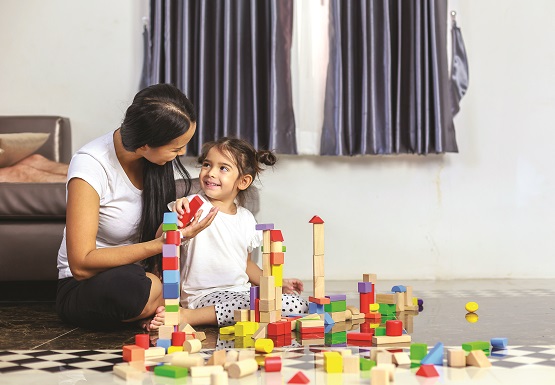Paediatrics
The Beginner’s Guide To Taking Care Of Your Infant: 7 To 12 Months

Your little one has gone from a tiny baby to a curious infant, ready to discover the wonders of the world. It’s an exciting time for you as you bond with your new little bundle of joy – the sudden wide-eyed smiles, gurgling laughter, and the witnessing of many firsts.
This article was written in collaboration with Professor Daisy Chan, Chairperson, Chapter of Neonatologists. It provides some tips on how to nurture a happy, healthy and growing infant.
Your Infant’s Development at This Age
This is an exciting time for you and your infant, as this little bundle of joy becomes increasingly mobile, with motor skills that seem to expand at such a rapid rate! At this point, this precious little one is also likely to be able to express likes and dislikes for certain foods and may even be able to babble certain syllables. During these 6 months, you may feel like things are going at express speed, with numerous new milestones¹ every day. Here’s what you can expect.
At 7 to 9 Months
Your infant will be able to push himself or herself up onto the hands and knees and will soon start crawling. The next step milestone would be to follow your movements. Picking up objects will start to be a common occurrence as your infant starts to discover how to use the index finger and thumb to grasp objects.
Ensure your infant is safe while exploring new grasping skills by only offering larger toys with smooth curved handles (such as teething rings) and avoid small objects that may be swallowed accidentally. Toys given to your infant should be intact without small pieces that could break off.
Your infant may get visibly excited and stimulated playing with toys. You may want to choose brightly coloured toys as they will stimulate your infant’s vision as compared to pastel-coloured ones.
This is also a good time to teach your infant the first words by allowing him/her to look at your mouth when you make sounds with the letters B, P, M or W. Your infant will copy your lip movements and start babbling word-like sounds with a variable intonation as if in conversation, which is also known as “baby-talk.”
At 10 Months
Your infant will begin to sit on their own. They will also be able to shift their position from sitting to lying down and from lying down to sitting. They will be able to sit steadily without falling and may also be able to creep on their tummy on the floor.
You will be filled with joy to hear your infant making sounds such as ‘mama’, and ‘dada’ and even waving bye bye to you. He/She may even respond if you ask simple questions such as “Where is mummy?” or “Where is daddy?”.
When you are dressing your infant, he/she may surprise you by holding out an arm or a foot.
At 11 to 12 Months
Your infant will begin to try standing and walking with some support, for example, by holding on to furniture. Soon, your little one will be able to stand without help from you, and before you know it, he/she will be taking his/her first steps! Do consult your doctor if your infant is not sitting unaided by 12 months old.
Your infant will also start copying your lip movements when you talk or sing to your infant to say first words such as “BABY, PAPA, MAMA, WO-WO”. It is alright if the pronunciation isn’t clear, because the aim is to encourage the imitation of new words or word-like sounds. For e.g., your little one might say “—NANA” for banana or “—PLE” for apple. Do consult your doctor if your infant is not making baby-talk or babbling by 12 months old. A hearing test may be needed to ensure that your infant can hear well.
Your infant will also begin to understand simple sentences such as “where is your book”.
Looking to understand your infant better? Find out more about how your infant is growing.
You are also encouraged to assess your child’s development using the Development Checklist within the Child Health Booklet. There is also the convenient option to use the Digital Health Booklet to electronically capture your child’s developmental milestones and immunisation schedule.
Follow a Sleep Routine for Your Infant
Your infant would have developed an established and regular sleep routine. While they would be getting less sleep as they grow up, most infants at this age will still need to have 2-3 daytime naps that last 30 minutes to 2 hours. You may consider phasing out night feeds if your little one no longer needs them.
Feed Your Growing Infant Right
Your infant is starting to have increased developmental and nutritional needs. It is now time to try solids so that your infant can discover food with different textures and tastes! This process is called weaning, where an infant gradually gets used to food other than milk. When your infant is ready to wean, you will see signs, such as showing interest in your food, sitting up with support, or being hungry even after a milk feed.
Prepare Food Without Sugar and Seasonings
It is best to start your infant early to accept natural flavours and build up the habit of eating low salt/sugar foods. Prepare food without salt, sugar or other seasonings where possible. Your infant’s kidneys cannot handle more than 1 gram of salt per day (i.e. about 1/6 teaspoon) until they are at least 12 months old.
Encourage Healthier Snacks and Fluids
Feed your infant with healthy finger foods such as vegetables or fruits, and brown rice cereal. Soft drinks, flavoured milk, juice, and dried fruit are high in sugar and calories, and may cause unintentional weight gain, so, avoid sugary drinks and snacks!
Create a Meal Routine
Try setting a regular time for breakfast, lunch, dinner and snacks. Once your infant gets used to the meal routine, mealtime becomes an anticipated activity and would be easier and more enjoyable.
Give your infant time to finish the food
It takes time to get used to solids after months of having a liquid diet. If your infant is apprehensive or not interested, don’t rush or pressure. Instead, give your infant milk, and try again with solids at the next meal.
Slowly Tweak Your Menu as Your Infant Grows
Generally, at about 9 months old, an infant will not need food to be blended and mushy anymore. At this point, you can try making roughly chopped soft food. This will prepare your infant for the next milestone – eating on his own.
More on getting your infant ready for solids here.
Check out Parent Hub: Recipes for interesting weaning meal ideas.
Oral Care for Your Teething Infant
Your infant’s teeth may begin to appear. Good oral care will help your infant to chew food well when you introduce a weaning diet, speak clearly, as well as prevent tooth decay.
Spot the First Signs of Teething
When your infant starts teething, you may notice signs such as red, swollen or bulging gums. There may also be excessive drooling, or your infant may start gnawing, sucking, and chewing on their fists or toys. Additionally, he/she may be restless at night.
Ease the Discomfort
To soothe your infant’s sore gums, you can use a clean finger or wet gauze to numb the gums – the pressure helps to ease the discomfort. You can also get something chilled, such as a teething ring or a spoon to place on the gums – do, however ensure that the object is not frozen as it can hurt your infant’s gums.
Book Your Infant’s First Dental Appointment
It is best to take your infant to the dentist anytime within the 6-to-12-month mark. This allows the dentist to prevent and anticipate problems rather than treat them. The dentist will also be able to evaluate your infant’s risk of cavities, evaluate adverse habits and customise a dental care programme specially for your child.
Need more tips on cultivating food oral health habits from a young? Learn more here.
Keeping Your Infant Safe
Your infant is now curious and exploring everything in wonder, and probably accidentally getting into trouble – a socket here, a wire there, or that sharp edge on your table you’ve never noticed. Hence, keeping a safe environment is a priority. Here are some infant-proofing tips.
Carry and Hold Your Infant Properly
Avoid holding your infant by the shoulders, arms or legs to shake. Excessive shaking can cause “Shaken Baby Syndrome”, which can lead to serious head injuries, and in some cases, even death or irreversible disability.
Place Your Infant on a Firm Flat Mattress
Your infant’s head might sink into soft surfaces and this increases the risk of suffocation. So, avoid large soft toys, soft pillows and bolsters.
Build a Safe Sleeping Spot for Your Infant
It is safer for your infant to sleep in his cot or bed. Bed-sharing, especially when you are in deep sleep, poses a risk to your infant as you could deprive him of oxygen if you roll over him. Additionally, remove loose objects such as blankets, stuffed toys, ropes, or string in the sleeping area, as these increases the risk of entrapment, suffocation and strangulation.
Infant Proof Your Electrical Outlets
Get childproof covering for your electrical sockets, so that your child’s little fingers won’t be in contact with any electrical currents, which can be dangerous especially with wet hands.
Get Corner Guards for Sharp Corners
Sharp corners are everywhere – on your tables, cabinets, shelves and more – and these guards are a quick fix to protect your infant. Try getting to your infant’s level to see which sharp corners may be within reach – for example, low-lying edges on coffee tables, drawers and cupboard doors.
Keep Breakable Items Out of Reach
Store potentially breakable items on higher shelves, and at the same time, make sure that nothing can be accessed even if your infant manages to find a chair to stand on. For spaces at home with many breakables, you can consider getting a gate to prevent your child from entering it entirely.
Avoid Exposing Your Infant to Cigarette Smoke
Passive smoking can be damaging to infants’ health, as their airways and lungs are still developing. Second-hand smoke can impair infants’ breathing and heart rate. It also makes them more likely than other children to develop health conditions such as asthma, bronchitis, and tonsilitis. There is also the issue of third-hand smoke, where babies touch the surface in an area where someone had been smoking and then put their fingers and hands into their noses and mouths. Avoid smoking near the infant or any surfaces that he may touch – including your clothes and hair as that could lead to your infant breathing in the second-hand smoke on your clothes and hair too.
Learn more about making your home safe for your infant here.
Give Your Little One a Head Start!
Reading, playing games and having some fun outdoors help to stimulate² your infant mentally, physically and socially. Here are some ideas:
Sing-along Songs
Your infant will have fun learning these action songs, such as “Itsy Bitsy Spider” and “Pop Goes the Weasel” and trying to follow the movements! Guide him/her to clap to the beat of the song by opening and closing the infant’s hands if unable to do so on his/her own.
Sensory Games
Your infant needs a platform to create, imagine and learn! Sensory bins filled with materials such as water, sand, rice, or shredded paper – can help your infant discover, imagine, and engage their senses. Keep an eye and ensure that your infant stay safe and doesn’t swallow anything that could be potentially harmful. You may also build up your infant’s sensory awareness early by introducing him/her to different textured materials such as grass, rugs, sand, towel (soft and rough) etc.
The “Feed Yourself” Challenge
Encourage your infant to feed himself or herself to promote fine motor skills, hand-eye coordination and independence. It’s going to be messy and dirty, but your little one is given the opportunity to explore and develop new skills. Most importantly, they will have so much fun learning!
Peekaboo
Ah, this one almost never fails to entertain any infant. Give the classic game a twist by hiding your face with a cloth and getting your infant to pull it off.
Move About
Encourage your infant to reach out to objects in front of him/her and slowly move the object further so that he/she needs to crawl or pull themselves towards the object. Pulling up the infant from a lying position to a standing position will increase muscle strength. He/she will also learn patterns by watching and mirroring your movement eg. bouncing a ball or opening and closing your fingers.
Learn more about activities to boost your infant’s motor, visual and auditory development here.
Taking care of your infant requires care, attention, and research. However, with the right knowledge, caring for your infant can be less overwhelming than it seems to be at first. You will have more headspace to enjoy the present and look forward to his or her next stage of growth.
Source: Health Promotion Board
The article has been endorsed by various representatives from both public and private healthcare institutions including Ms Adeline Kooh Seok Koon (Asst Director, Nursing (Maternity), Mount Alvernia Hospital).
Visit Health Promotion Board’s Parent Hub, for more useful tips and guides to give your baby a healthy start.



